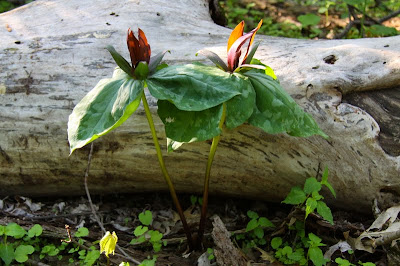Friday, May 20, 2011
Wednesday, May 18, 2011
A ramble down Nautilus Point Park greenway
.
On May 17, I took a short ramble down the greenway, along the stream. It's tough going--there's no path, sometimes the banks to the stream are steep, and you have to climb over fallen logs.
But I was rewarded with many wild animal tracks.
...and a few woodland wild flowers, like this trillium.
Coyote track, the size of a mid-sized dog's. Coyotes use greenways, streams, and lakeshores to travel about town unseen.
This stream suffers from the ills of most urban streams--too little flow when it's not raining, and too much when it does rain. This causes bank erosion during rain, plus lack of vegetation and wildlife from the dry times.
Hiking back to my car parked on Masthead Dr., I could see some magnificent oaks bordering the greenway.# # #
This greenway has infestations of garlic mustard and buckthorn.
See all the photos here.
See all the photos here.
Monday, May 16, 2011
"Today, we learned that Governor Scott Walker intends to issue an Executive Order to completely restructure the DNR in a way that will protect polluters and prevent public input.
Of all the attacks we've seen on natural resources so far this session, this one takes the cake – by far.
The DNR is the agency that implements and enforces the laws that protect the water we drink, the air we breathe, and the places that make Wisconsin special. Under the proposed new structure – all of those things are in jeopardy.
Read the Milwaukee Journal Sentinel's story here and the Wisconsin League of Conservation Voters' press release here."
Thanks to Jennifer Giegerich, WI League of Conservation Voters
Of all the attacks we've seen on natural resources so far this session, this one takes the cake – by far.
The DNR is the agency that implements and enforces the laws that protect the water we drink, the air we breathe, and the places that make Wisconsin special. Under the proposed new structure – all of those things are in jeopardy.
Read the Milwaukee Journal Sentinel's story here and the Wisconsin League of Conservation Voters' press release here."
Thanks to Jennifer Giegerich, WI League of Conservation Voters
Friday, May 13, 2011
How I became a woodland gardener
If you have lots of shade, and no money for plants--
here's an easy method.
I used to have a traditional yard--almost entirely grass, with shrubs around the edges.
Along the side, between my house and the next, it was very shady. Grass would hardly grow there, but the weeds did. I’d mow it twice in the summer to lop off the scraggly weeds. The mower would kick up clouds of dust--I’d have to hold my breath. In the fall, I raked leaves--creating more clouds of dust.
My yard (right) used to be as barren as the left side of the fence.
Every springtime, I noticed lots of violets had colonized since mowing last fall. They were pretty--it seemed a shame to mow down all those pretty flowers. Gradually it dawned on me--maybe the violets were better than dust and weeds, mowing and raking.
Thursday, May 5, 2011
Meeting scheduled for Parman Place development
Thursday, May 12, 2011, 6:30 p.m. - 8:30 p.m.
Edgewood College, 1000 Edgewood College Drive
Wednesday, May 4, 2011
Clean Water Act Definition of "Waters of the United States"
"Americans depend on clean and abundant water. However, over the past decade, interpretations of Supreme Court rulings removed some critical waters from Federal protection, and caused confusion about which waters and wetlands are protected under the Clean Water Act. As a result, important waters now lack clear protection under the law, and businesses and regulators face uncertainty and delay.
Tuesday, May 3, 2011
Don't miss this talk on new technology in urban forestry!
The Urban Forest is Broken: Solutions for a Pending Crisis
6:30pm, Thursday, May 5th, 2011
Bethany Evangelical Free Church, 301 Riverside Dr., Madison
Large Trees, Suspended Pavement & Stormwater Management will be discussed by Peter McDonagh
Madison's air has high levels of particle pollution
 |
| Many pounds of mud per tire |
Construction sites are a major source of dust in the air. When vehicles leave construction sites, they lay a track of mud that lasts for miles. The mud turns to road dust--soon becoming air pollution.
Subscribe to:
Comments (Atom)





